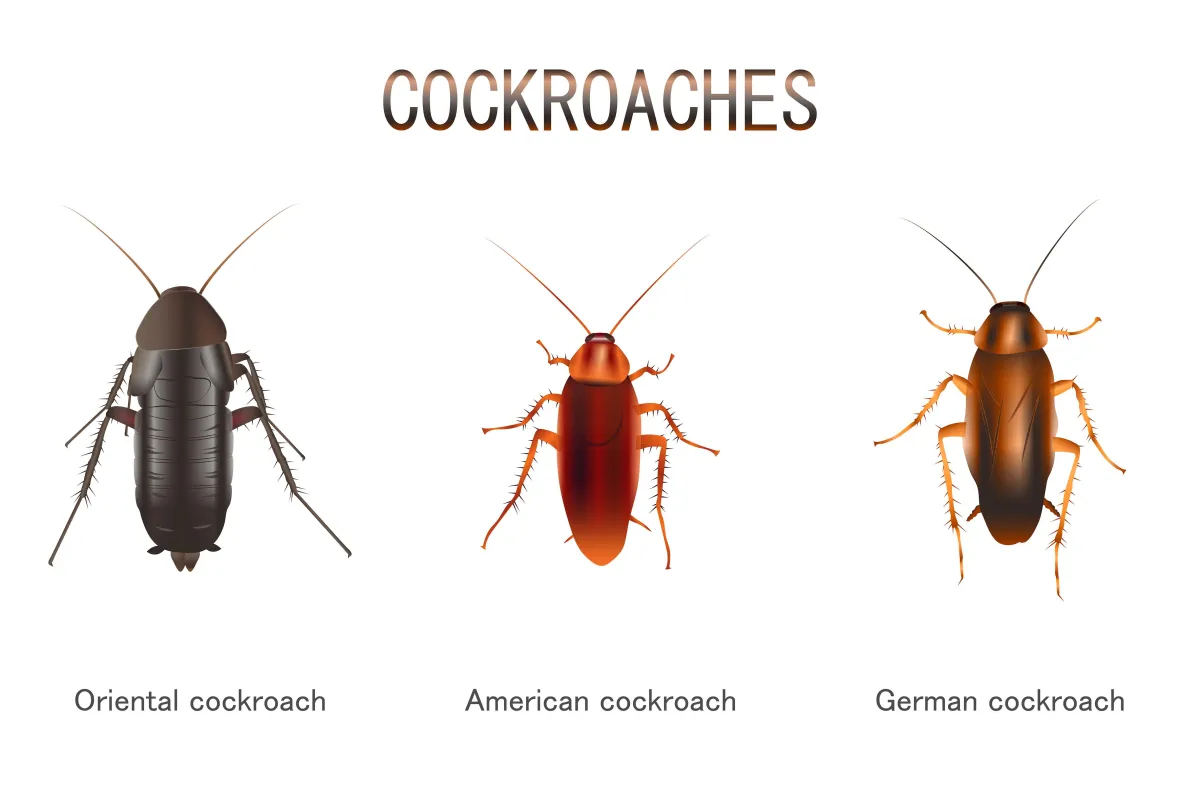Blog
Explore insightful and informative pest control blogs

"Cockroaches: The Uninvited Pests We Can't Seem to Shake"
Ah, cockroaches! These creepy crawlers have been plaguing Northwest Arkansas properties for centuries – and they don't seem to be going anywhere anytime soon. While they may be a nuisance, cockroaches can actually be beneficial to humans in some ways. Here's what you need to know about these resilient pests.
Cockroaches are some of the oldest living creatures on our planet. They have been around since the time of the Cockroaches are one of the most well-known and disliked pests in the world, and for good reason. They are able to invade homes and businesses, eat through food sources, and create unpleasant odors. However, there is more to these insects than meets the eye. In this blog, we will delve deeper into the world of cockroaches, exploring their biology, behavior, and ecological importance.

Biology
Cockroaches are insects belonging to the order Blattodea, which includes around 4,500 species of cockroaches, termites, and their close relatives. They are found in all parts of the world, except Antarctica, and are particularly common in warm and humid environments.
Morphology
Cockroaches have a flattened, oval-shaped body with a tough, chitinous exoskeleton that protects them from predators and the environment. Their body is divided into three regions: the head, thorax, and abdomen. The head contains the mouthparts, sensory organs, and compound eyes. The thorax has three pairs of legs and two pairs of wings (in most species). The abdomen contains the digestive, reproductive, and excretory organs.
Cockroaches vary in size from a few millimeters to over 10 centimeters in length, depending on the species. They also have a variety of colors, including brown, black, red, and yellow.

Physiology
Cockroaches have a unique physiology that allows them to survive in a wide range of environments. They have a slow metabolism that allows them to conserve energy and survive for long periods without food or water. They can extract water from the air and their surroundings, which helps them to survive in arid environments.
Cockroaches have an open circulatory system, which means that their internal organs are bathed in a fluid called hemolymph. They also have a simple respiratory system that involves small tubes called tracheae that deliver oxygen directly to the cells.
Cockroaches have a simple nervous system that includes a brain and several ganglia that control their movements and behavior. They also have a complex digestive system that allows them to digest a variety of organic matter, including wood, paper, and even cloth.
Lifecycle
The lifecycle of a cockroach consists of three stages: egg, nymph, and adult. The female cockroach lays eggs in an ootheca, which is a protective capsule that contains multiple eggs. The number of eggs in each ootheca varies depending on the species, but can range from a few dozen to several hundred.
The nymph hatches from the egg and looks like a miniature version of the adult cockroach. However, it lacks wings and is not yet sexually mature. As the nymph grows, it sheds its exoskeleton multiple times in a process called molting. Each time it molts, it becomes larger and more developed.
Once the nymph reaches adulthood, it is able to mate and reproduce. Adult cockroaches can live for several months to a year, depending on the species and environmental conditions.

Behavior
Cockroaches are primarily nocturnal insects, meaning they are most active at night. During the day, they hide in dark, humid places such as cracks in walls, under appliances, or inside cabinets. They are attracted to warmth, moisture, and food sources, and they will often infest kitchens, bathrooms, and other areas where these resources are abundant.
Cockroaches are omnivorous, meaning they eat both plant and animal matter. They will consume almost anything, including fruits, vegetables, grains, meat, and even glue or paper products. Cockroaches have a unique ability to survive on very little food and water, making them incredibly resilient and adaptable. They can go without food for up to a month and without water for up to two weeks.
Cockroaches reproduce rapidly, with females capable of producing hundreds of offspring in their lifetimes. They mate through a process called "traumatic insemination," in which the male pierces the female's abdomen with his reproductive organ and deposits his sperm directly into her body cavity. The female then stores the sperm and uses it to fertilize her eggs as she lays them. Cockroach eggs are enclosed in a protective capsule called an ootheca, which the female carries around with her until the eggs hatch.
Ecological Importance
Despite their negative reputation as pests, cockroaches do play an important role in ecosystems. They are scavengers, helping to break down organic matter and recycle nutrients. They also serve as food for many predators, including birds, reptiles, and mammals. In some cultures, cockroaches are even considered a delicacy and are consumed as food.
Cockroaches have also been studied for their potential medical benefits. Some species produce compounds that have antibacterial and antifungal properties, which could be useful in developing new antibiotics. Cockroach venom has also been shown to have potential in treating cancer, as it contains peptides that can kill cancer cells while leaving healthy cells unharmed.
Health Risks
Cockroaches can pose several health risks to humans. They are known to carry bacteria, viruses, and parasites that can cause various diseases. Some of the health risks associated with cockroaches include:
Allergies: Cockroach droppings, saliva, and shed skin can trigger allergic reactions in sensitive individuals. Symptoms of cockroach allergies include sneezing, wheezing, coughing, and skin rashes.
Asthma: Cockroach allergens have been linked to the development and exacerbation of asthma in some people. Exposure to cockroaches can trigger asthma attacks in asthmatic individuals.
Food contamination: Cockroaches can contaminate food with bacteria such as Salmonella, E. coli, and Staphylococcus, which can cause food poisoning.
Disease transmission: Cockroaches can carry and transmit various diseases, including typhoid fever, cholera, dysentery, and gastroenteritis.
Respiratory infections: Cockroaches can carry bacteria that cause respiratory infections such as pneumonia, especially in vulnerable populations like children, the elderly, and people with weakened immune systems.
Skin infections: Cockroaches can carry bacteria that can cause skin infections, such as impetigo and cellulitis.
To minimize the health risks associated with cockroaches, it is important to maintain a clean and sanitary living environment, seal off entry points, and address any pest infestations promptly.
Prevention and Control
Preventing and controlling cockroach infestations requires a combination of sanitation, exclusion, and chemical treatments.

Sanitation
The first step in preventing cockroach infestations is to keep your home or business clean and free of food and water sources. This includes:
Keeping countertops, floors, and appliances clean and free of crumbs and spills.
Storing food in sealed containers and cleaning up food spills promptly.
Fixing leaky pipes and faucets to prevent excess moisture.
Taking out trash regularly and keeping trash cans clean.
Vacuuming carpets and floors regularly to remove crumbs and debris.
Exclusion
Excluding cockroaches from your home or business is also important. This can be done by:
Sealing cracks and crevices in walls, floors, and cabinets.
Installing door sweeps and weatherstripping to prevent cockroaches from entering through doors and windows.
Inspecting packages and boxes for cockroaches before bringing them inside
.
Chemical Treatments
Chemical treatments can also be used to control cockroach infestations. These may include baits, sprays, and dusts that are applied to areas where cockroaches are likely to hide and feed. It is important to follow the instructions on the label carefully and to use these products safely and responsibly.
Cockroaches are fascinating and complex insects that play important roles in ecosystems around the world. However, they also pose significant health risks and can be difficult to control once they have infested a home or business. By practicing good sanitation, exclusion, and chemical treatments, it is possible to prevent and control cockroach infestations and keep these pests at bay.
Don't let pests put a damper on your Northwest Arkansas lifestyle - Network Pest Control has the most effective, safe and environmentally friendly methods to get rid of your pest problem - fast! Contact us today for a free consultation or inspection and take back control of your home and business!
Craving a Superior Pest Control Solution?
COMPANY STORY
& EXPERIENCE
Craig Broadhead started his pest business in 2004 in California, called Pacific Pest Control. In 2021, he sold his business and moved his family to Arkansas to start fresh with a new vision of Network Pest Control. His goal it to make sure each customer has the best experience possible.


Network Pest Control
11205 Meadow Lark Rd. Rogers AR 72756
479.888.4249
